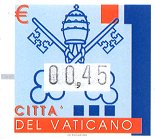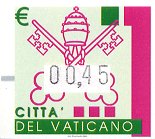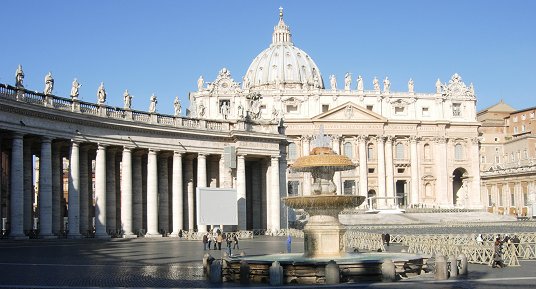| Vatican City (Città del Vaticano) |
|
 |
Every day the Vatican City welcomes thousands of visitors. Tourists and pilgrims rub shoulders as a large body of people who occupy all the public spaces of this small city-state within Rome. They come, either to visit its museums and monuments, or to participate in the different religious acts and Papal audiences.
One of the most appreciated souvenirs amongst tourists, from wherever they come, is the sending of postcards from the post offices of the Poste Vaticane.
In order to meet this important and continuous demand for stamps, Poste Vaticane decided at the end of 1999 on the purchase and installation of 2 automatic public vending machines for the sale of ATMs (or francobolli automatici, as they are called in Italy) by the Swiss company Frama. These machines were sold in Italy by the Francopost company.
In 2000, the two public vending machines were installed in St. Peter's Square, in the entrance way to the post offices of Arco delle Campane (Arch of the Bells) and Guardia Svizzera (Swiss Guard). Their external location lets visitors obtain stamps at any time, even when the post offices are closed.
These are possibly the 2 best located ATM vending machines worldwide. The picture on the right shows the view of the Basilica of Saint Peter from one of these machines ... |
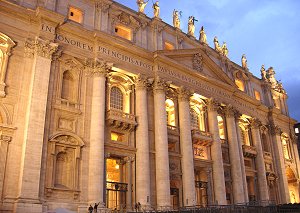 |
The Arco delle Campane post office is located on the left side of the Basilica of Saint Peter, in front of the Vatican gate of the same name. It is the most visited by tourists, because of its location on the exit route after a visit to the Basilica.
The Frama machine installed in this post office has been out of service for long periods during recent years. |
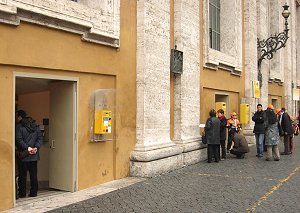 |
The Guardia Svizzera post office, located near the Swiss Guard headquarters and under the Apostolic Palace, is both less well known and visited, because it is partially hidden by the right wing of the Bernini's colonnade.
On the outside wall of this post office there is a phonecard vending machine, public telephones, some mailboxes and an ATM dispenser.
|
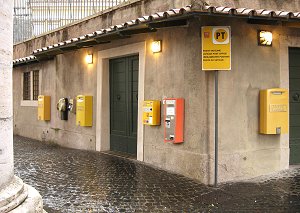 |
 |
The type of Frama ATM vending machine installed in the Vatican is very simple, as it neither offers any pre-programmed face values, or issues purchase receipts.
In the lower right corner of the machine there is a tablet with information about the main postal rates. The user can key in the face value required and the machine prints and issues the corresponding variable value stamp (ATM). Payment is only possible with coins, and the machine does not return any change, but automatically, and after a longish delay, delivers any ‘change’ as an ATM.
These machines are fitted with a mechanical head that prints using wheels of digits. For the issue of stamps (ATMs) they use rolls of gummed labels, on which is printed the corresponding face value, in black ink. The final step is the cutting and issue of the stamp. |
ATMs with a face value equal to or higher than the basic rate for inland mail are issued immediately. Values below this, or the value currently programmed into the vending machines, can only be obtained from the ‘change’ to be given back by the distributor in the form of ATMs, as a residual values, or by inserting a coin and waiting for the automatic issue of this value as a residual ATM. The programmed waiting time has increased from the 20-30 seconds in the early years, to the current 60 long seconds. Thus the minimum face value that can be obtained in these machines coincides with the minimum value of the coins accepted at the current time: 50 Italian liras until 2001 and 0.01 EUR from the change of the monetary system in 2002.
In addition to the 2 public Frama vending machines, the Ufficio Filatelico (Vatican philatelic service) had another internal use machine to meet the philatelic orders, but it is not longer in use. |
 |
| Frama distributor in the Arco delle Campane post office. Photo: C. Schleicher |
The first series could be obtained from the new Frama vending machines from March 15th 2000. They are 5 beautiful designs appearing consecutively, within the rolls, and commemorating the Holy Year 2000, with the images of the Coat of Arms of His Holiness John Paul II and the 4 Papal Basilicas in Rome.
The rolls were manufactured by the Swiss company Hélio Courvoisier on gummed paper, with fibres. When issued by the distributors, the ATM size is 40 x 35.70 mm.
The Frama vending machines allowed the direct issue of ATMs with face values between 400 and 5000 liras, in steps of 50 liras. The small values (from 50 liras) could be obtained as change in the form of ATMs, or by inserting a coin and waiting some seconds until the automatic issue of the corresponding stamp.
 |
 |
 |
Coat of arms of John Paul II
Cristo ieri, oggi, sempre ! |
Basilica di San Paolo - Roma |
Basilica di San Giovanni in Laterano - Roma |
 |
 |
| Basilica di San Pietro in Vaticano |
Basilica di Santa Maria Maggiore - Roma |
| The Ufficio Filatelico prepared a first day commemorative postmark (Prime Die) that, again, reproduces the coat of arms of John Paul II. |
 |
| From left to right, Basilica of Saint Peter in the Vatican, interior of the St. John Lateran Basilica in Rome, and St. Mary Major Basilica, also in Rome. |
 |
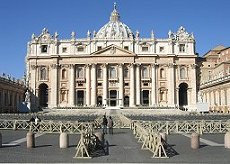 |
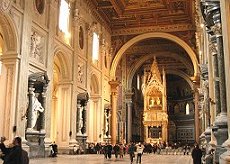 |
| 2001. Vatican gold coins (1996-2000) |
The second series of designs for the Frama distributors was issued from May 22nd 2001. In this case, the pictures reproduce 5 gold coins issued between 1996 and 2000 in the Vatican City.
As with the previous issue, the rolls were manufactured by Hélio Courvoisier, on gummed paper with fibres, and the ATM size is 40 x 35.7 mm.
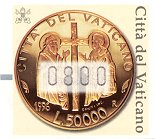 |
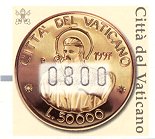 |
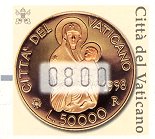 |
| Saints John the Evangelist and John the Baptist - 1996 |
Saint Paul
1997 |
The Virgin and Child - 1998
(Maria Salus Populi Romani) |
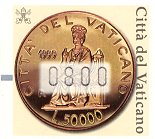 |
 |
Saint Peter
1999 |
Parable of the Prodigal Son
2000 |
A First day cover and commemorative postmark (Die emissionis) reproducing a part of the icon of the Virgin 'Salus Populi Romani' (meaning Protectress of the Roman People).
This image is believed to be painted by Saint Luke the Evangelist (see next series) and is located in the Santa Maria Maggiore Basilica in Rome (see previous series). |
 |
| 2002. The four Evangelists |
The next series reproduces the pictures of the 4 Evangelists with their symbol; Saint John with the eagle, Saint Luke with the ox, Saint Matthew with the winged human and Saint Mark with the lion.
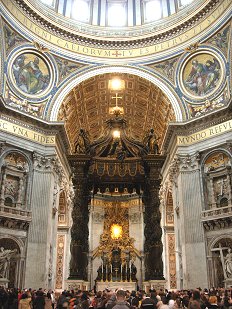 |
These pictures are taken from the mosaics made in 1599, in the 4 spandrels located in the base of the dome of the Saint Peter's Basilica, above St. Peter's tomb and the Bernini's canopy.
The two first mosaics, St. John and St. Luke are painted by Giovanni de' Vecchi whilst St. Matthew and St. Mark are a work of Cesare Nebbia.
|
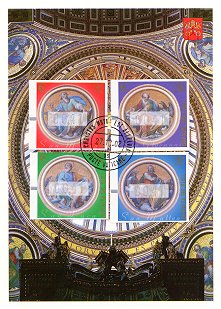 |
| Postcard with the 4 ATMs overlaid on an interior view of the dome |
After the closure of the Swiss printers, in May 2001, the new rolls of gummed paper labels were manufactured by the British company Walsall Security Printers, which had acquired the machinery and key assets of Courvoisier, and continued its business.
The first day of issue of this new series was March 12th 2002, although on that date it was only possible to obtain ATMs in the Ufficio Filatelico. They prepared a short first printing run. The two FRAMA vending machines for public use had been out of service over several months, to be adapted to the new European monetary system, the EURO.
The ATMs of this first impression are printed on a paper with a fluorescent layer, and they can also be recognized because it is a better quality printing and has side texts in a silver-plated color. The gum is matt.
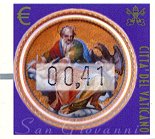 |
 |
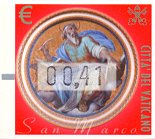 |
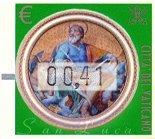 |
| San Giovanni |
San Luca |
San Matteo |
San Marco |
The ATMs were available to the public from the Frama vending machines from May 13th 2002, although, surprisingly, the rolls belonged to a reprinting of the previous series, which had been manufactured on normal - non fluorescent paper with fibres (clearly visible on the back), and the gum is a little more brighter. The texts have a golden shade.
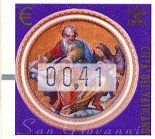 |
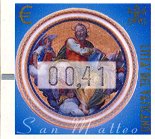 |
 |
 |
| San Giovanni |
San Luca |
San Matteo |
San Marco |
| First day cover with one of the 4 ATMs and commemorative postmark (Die emissionis). |
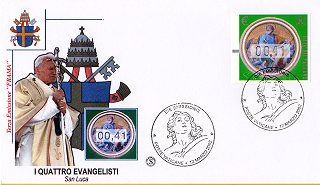 |
| 2004. The emblem of the Holy See |
The ATM series issued in June 3rd 2004 consists of 3 images with the coat of arms or the emblem of the Holy See, the crossed gold and silver keys surmounted by the Papal tiara. They used a single design and colour combinations: blue and red; red and yellow; and lilac and green.
The emblem is also the subject of the issue day commemorative postmark (Die emissionis). |
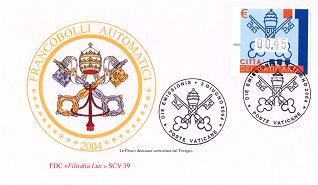 |
The new manufacturer of the rolls of labels, on gummed paper, was the Dutch security printing company Joh. Enschedé.
The Vatican Philatelic Service sold these ATMs in a set made up from the 3 designs each with the basic franking of 0.45 EUR, corresponding to the rate for an inland letter up to 20 g. on the date of issue. Other values could be obtained, as usual, from the 2 automatic distributors installed at St. Peter's Square.
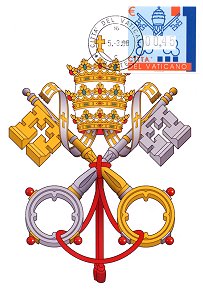 |
 |
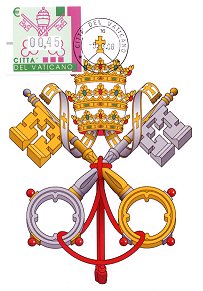 |
| Maximum cards, last day of issue date postmark |
| 2008. Basilica and colonnade |
Four years after the last series, the Vatican Ufficio Filatelico surprised collectors with the announcement of a new issue of francobolli automatici.
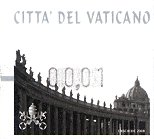 |
The new design shows a black and white picture of the left wing of Bernini's colonnade, that encloses St. Peter's square, and the cupola of the Vatican Basilica in the background. The original picture is by Biagio Tamarazzo. The text is printed in a silver-plated color, and in the lower left corner is the Vatican emblem, as with all the previous issues.
The first day of issue was March 6th 2008. Exceptionally, on that date, the 2 Frama distributors were in service. |
| The rolls of 1,200 labels were, again, manufactured by Joh. Enschedé on gummed paper and, as a new feature on Vatican ATM issues, a preprinted number appears on the back of every fifth label, indicating the number of labels still remaining on the roll. |
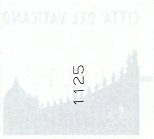 |
Another important introduction: For the first time, the Ufficio Filatelico ordered from the printers a special stamp edition with the same design and a preprinted face value of 0.85 EUR (the postal rate for a letter of up to 20 g., to America, Asia and Africa by priority mail).
As can be seen in the images below, the printing of the face value is totally different for a non ATM stamp, with the preprinted face value (left image, sold by the Ufficio Filatelico) compared with a variable value stamp (ATM) issued by one of the 2 Frama distributors installed in St. Peter's square (right image). |
 |
 |
 |
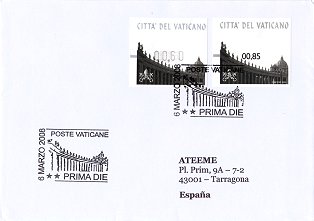 |
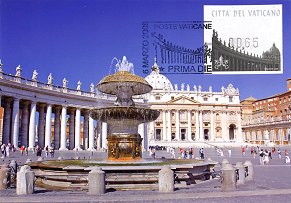 |
| Cover posted with one ATM (0.60 EUR) and one stamp with the preprinted face value (0.85 EUR), tariff for a letter to European countries and weight from 20 to 50 g., and a maximum card. First day of issue commemorative postmarks (Prima Die). |
| The main postal tariffs in the Vatican |
Letters and
postcards
up to 20 g. |
Vatican
and Italy |
Europe and
Mediterranean
countries |
Africa, Asia
and America |
Oceania |
Posta
Ordinaria |
Posta
Prioritaria |
Posta
Ordinaria |
Posta
Prioritaria |
Posta
Ordinaria |
Posta
Prioritaria |
Posta
Ordinaria |
Posta
Prioritaria |
| 2000 |
800 |
1200 |
800 |
1200 |
1000 |
1500 |
1000 |
1500 |
| Change of monetary system - EUR |
| 1.01.2002 |
0.41 |
0.62 |
0.41 |
0.62 |
0.52 |
0.77 |
0.52 |
0.77 |
| 1.01.2004 |
0.45 |
0.60 |
0.45 |
0.62 |
0.65 |
0.80 |
0.70 |
1.00 |
| 1.07.2006 |
- |
0.60 |
- |
0.65 |
- |
0.85 |
- |
1.00 |
You will be able to read this article also in VARIABLE 8 (edition April 2008).
ATM Web - Spain and Latin American Postal Services: http://www.ateeme.net
© J. Jove - M. Sans. ATEEME. Variable value stamps study group. All rights reserved
This page was first created in August 2002 and last updated:
28.03.08
. English edition rewritten by S. Goodman (21.03.08)
|

































